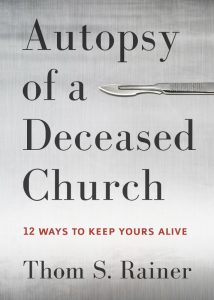
Rainer, Thom S. Autopsy of a Deceased Church: 12 Ways to Keep Yours Alive. Nashville: B&H, 2014. 102 pp. $12.99.
Many churches die every year all across the United States. While one might argue that some need to die, a church’s death is sad, and in many cases, preventable. In this brief work, Thom Rainer examines the conditions of multiple churches that contributed to their ultimate demise. Based on his findings and the knowledge gained from years of research, Rainer outlines nine symptoms of sick or dying churches, then offers twelve “responses” intended to help the members of those churches confront their situation.
Despite the book’s brevity (which some may find refreshing in today’s social-media culture), the content is weighty and insightful, offering readers information to help identify areas within their churches that indicate sickness or impending death. The book is divided into two parts: the autopsy and the responses. In the first section, Rainer explains that for many, the journey toward death is slow and often goes unnoticed (ch. 2). Chapters 3-11 outline conditions, or symptoms, of a sick or dying church. Some of the symptoms Rainer discusses include idolization of the past, self-serving budgeting, being “preference-driven,” and a fixation on church facilities.
Although the book is intended for a more general audience, it can be a useful resource for church leaders and scholars. Rainer, in a style reminiscent of his online articles, strips the information of illustrative fluff and provides church leaders—in a direct, yet loving, manner—the necessary information to recognize and address spiritual sickness in their church. Scholars will find the information useful in that it (1) provides a snapshot of the American church’s spiritual condition in the early twenty-first century, and (2) can work well in conjunction with Revelation 2-3 (and other passages) in identifying how the American church relates to churches of the first century.
Despite its usefulness, Autopsy of a Deceased Church is not without weaknesses. First, some of the individual symptoms seem forced. For example, based on his explanations, it is unclear how being “preference-driven” (ch. 7) is distinct from the church refusing to look like the community (ch. 4). In both cases, Rainer indicates that the congregation is self-serving rather than kingdom-serving.
[bctt tweet=”.@ThomRainer’s #Autopsy is a tremendous value to Christians that can help slow the church death in the USA.” username=””]
In addition, one must ask whether the individual conditions are truly symptoms or merely byproducts of the symptoms of selfishness and pride. On the one hand, a case could be made that pride and selfishness are the disease and the nine issues Rainer addresses are the symptoms. On the other hand, one could argue that the disease is sin, the symptoms are selfishness and pride, and Rainer’s nine conditions are the byproducts. This lack of clarity is exacerbated by the fact that throughout the autopsy, Rainer repeatedly returns to the theme of the church being selfish and prideful.
Another weakness is Rainer’s dependence on his own ethos (i.e., “trust me” moments). Multiple times Rainer offers broad generalizations, especially regarding statistics, that he indicates are based on his overall research and experience. For example, when discussing the nature of a pastor’s tenure, Rainer lists five stages (58-60), which he precedes by referencing his “more than two decades” of research. He then admits that although his time-designations are “not precise,” he has “some level of confidence” in them.
A second example of Rainer’s ethos-dependence is in chapter twelve. Rainer estimates that 10% of churches are healthy, 40% have some symptoms, 40% are very sick, and 10% are dying. The given basis for these numbers, which he admits are “not precise,” is simply “I believe they reflect the actual condition” (86).
The final weakness comes in part two: the “responses” to spiritual sickness. Although the subtitle states that the book will included “twelve ways to keep yours alive,” Rainer actually only offers eight. The final four responses recommend letting the church die, albeit gracefully (ch. 14). Furthermore, Rainer qualifies his recommendations for a “very sick” church (ch. 13) by indicating that change would require a miracle because, though not impossible, it is very unlikely that such a church can avoid death (94).
Thom Rainer’s work, Autopsy of a Deceased Church, offers tremendous insight into the spiritual conditions that plague many churches in America. A few are healthy, some have early symptoms, while others are very sick or dying. It can be difficult to recognize sickness in a church at any stage, especially for the members of that church. Rainer’s work offers insight and information to help laity, leaders, and scholars identify and address areas of spiritual sickness. Despite its brevity, the book is a tremendous value to Christians that, when read with an open mind, can help slow the rate of church death in this nation.














